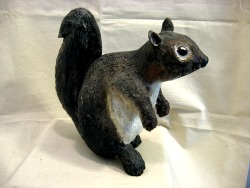C. Jean. Sculptor. Woodcarver. Quebec City. QC. Active 1950’s – 1960’s.
C. Jean was a flat-plane woodcarver. He made small unpainted carvings of birds and wild-life usually signed.
A Goose by C. Jean:
Mark of C. Jean:
Canadian Folk Art and Outsider Art
C. Jean. Sculptor. Woodcarver. Quebec City. QC. Active 1950’s – 1960’s.
C. Jean was a flat-plane woodcarver. He made small unpainted carvings of birds and wild-life usually signed.
A Goose by C. Jean:
Mark of C. Jean:
Diane Cote. Sculptor. Kamouraska, Quebec. Active 2oth century.
Diane Cote made sculptures of people using the crotches of small trees or branches. In the manner of Nova Scotia sculptor Stanley Rector. They were painted.
Guy Boudreau. Sculptor. Woodcarver. Mauricie, Quebec. Active 20th century.
Guy Boudreau made naïve painted figural carvings. He signed his work. An example is shown here.
A carving of a seated man by Guy Boudreau:
Ref: Musee quebecois de culture populaire. (A Trois-Rivieres.)
Leo-Jos. Bourguet. Sculptor. Lower Saint-Lawrence. Active 20th century.
Leo Bourguet made very elaborate sculptures using bottle caps.
Coll. Musee de la Civilization de Quebec.
Georges Racicot. Pointe-Calumet, QC. Sculptor. Woodcarver. Active mid to late 20th century.
Georges Racicot made painted carvings of animals, birds and forest creatures as well as human faces and totemic carvings. Carvings that he placed around his house and yard in Calumet, Quebec.
He had various methods of carving and shaping wood – often making coiled snakes by bending a green (fresh) branch around a sapling in the shape of a coiled snake. When it had dried over time he would free it and paint the snake – usually using ‘as found’ colours. Many of his painted faces were carved in a living standing tree in the manner of his aboriginal ancestors only cutting the face out after it had dried. He filled his yard with them, and other totems, as well as birds and animals. He often carved tools and utensils – cups and bowls – using traditional methods and materials. He was multi-talented and very inventive, drawing on the traditions of his background and ancestry. While he lived simply he was very sophisticated.
I must mention that Georges Racicot also built over the years a large and important collection of Quebec pottery. He was considered an expert in the field; in particular the Richelieu Valley and Quebec city potters.
A Canoe Cup made from a Burl by Georges Racicot:
The reverse:
Georges Racicot. His mark:


This work is licensed under a Creative Commons Attribution 3.0 Unported License. · LyleElderFolkArt.com · Site by padroneMedia